
Tillage is the agricultural preparation of soil by mechanical agitation of various types, such as digging, stirring, and overturning. Examples of human-powered tilling methods using hand tools include shoveling, picking, mattock work, hoeing, and raking. Examples of draft-animal-powered or mechanized work include ploughing, rototilling, rolling with cultipackers or other rollers, harrowing, and cultivating with cultivator shanks (teeth).

In agriculture, a harrow is an implement for breaking up and smoothing out the surface of the soil. In this way it is distinct in its effect from the plough, which is used for deeper tillage. Harrowing is often carried out on fields to follow the rough finish left by plowing operations. The purpose of this harrowing is generally to break up clods and to provide a finer finish, a good tilth or soil structure that is suitable for seedbed use. Coarser harrowing may also be used to remove weeds and to cover seed after sowing. Harrows differ from cultivators in that they disturb the whole surface of the soil, such as to prepare a seedbed, instead of disturbing only narrow trails that skirt crop rows.

Weed control is the botanical component of pest control, which attempts to stop weeds, especially noxious weeds, from competing with desired flora and fauna including domesticated plants and livestock, and in natural settings preventing non native species competing with native species.
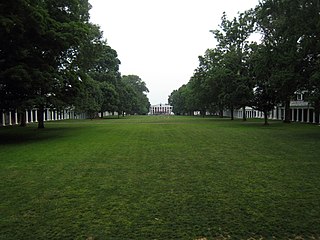
A lawn is an area of soil-covered land planted with grasses and other durable plants such as clover which are maintained at a short height with a lawnmower and used for aesthetic and recreational purposes. Lawns are usually composed only of grass species, subject to weed and pest control, maintained in a green color, and are regularly mowed to ensure an acceptable length. Lawns are used around houses, apartments, commercial buildings and offices. Many city parks also have large lawn areas. In recreational contexts, the specialised names turf, pitch, field or green may be used, depending on the sport and the continent.
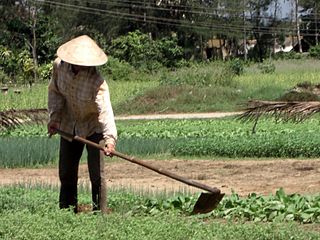
A hoe is an ancient and versatile agricultural and horticultural hand tool used to shape soil, remove weeds, clear soil, and harvest root crops. Shaping the soil includes piling soil around the base of plants (hilling), digging narrow furrows (drills) and shallow trenches for planting seeds or bulbs. Weeding with a hoe includes agitating the surface of the soil or cutting foliage from roots, and clearing the soil of old roots and crop residues. Hoes for digging and moving soil are used to harvest root crops such as potatoes.
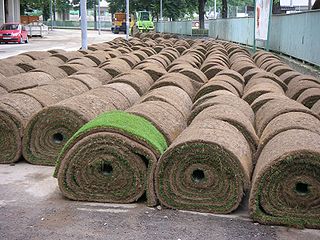
Sod, also known as turf, is grass. When harvested into rolls it is held together by its roots and a thin layer of soil.

The roller is an agricultural tool used for flattening land or breaking up large clumps of soil, especially after ploughing or disc harrowing. Typically, rollers are pulled by tractors or, prior to mechanisation, a team of animals such as horses or oxen. As well as for agricultural purposes, rollers are used on cricket pitches and residential lawn areas.

A rake is a broom for outside use; a horticultural implement consisting of a toothed bar fixed transversely to a handle, or tines fixed to a handle, and used to collect leaves, hay, grass, etc., and in gardening, for loosening the soil, light weeding and levelling, removing dead grass from lawns, and generally for purposes performed in agriculture by the harrow.
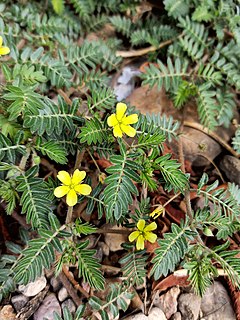
Tribulus terrestris is an annual plant in the caltrop family (Zygophyllaceae) widely distributed around the world. It is adapted to grow in dry climate locations in which few other plants can survive. It is native to warm temperate and tropical regions in southern Eurasia and Africa. It has been unintentionally introduced to North America and Australia. An aggressive and hardy invasive species, T. terrestris is widely known as a noxious weed because of its small woody fruit – the bur – having long sharp and strong spines which easily penetrate surfaces, such as bare feet or thin shoes of crop workers and other pedestrians, the rubber of bicycle tires, and the mouths and skin of grazing animals.

A cultivator is a piece of agricultural equipment used for secondary tillage. One sense of the name refers to frames with teeth that pierce the soil as they are dragged through it linearly. Another sense refers to machines that use rotary motion of disks or teeth to accomplish a similar result. The rotary tiller is a principal example.

Soliva sessilis, one of up to nine species of the genus Soliva, is a low-growing herbaceous annual plant. Its common names include field burrweed, Onehunga-weed, lawn burrweed, lawnweed, and common soliva. It is one of several plants known as bindi weed, bindii, or bindi-eye.
This is an alphabetical index of articles related to gardening.
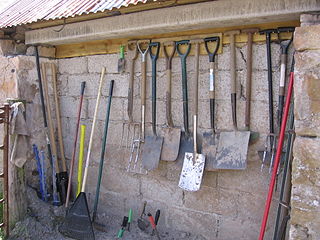
A garden tool is any one of many tools made for gardening and landscaping, which overlap with the range of tools made for agriculture and horticulture. Garden tools can be divided into hand tools and power tools.
Aeration is the process by which air is circulated through, mixed with or dissolved in a liquid.

A lawn aerator is a garden tool designed to create holes in the soil in order to help lawn grasses grow. In compacted lawns, aeration improves soil drainage and encourages worms, microfauna and microflora which require oxygen.
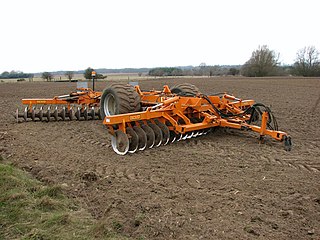
A disc harrow is a harrow whose cutting edges are a row of concave metal discs, which may be scalloped, set at an oblique angle. It is an agricultural implement that is used to till the soil where crops are to be planted. It is also used to chop up unwanted weeds or crop residue.
Magnaporthe poae is an ascomycete fungus which causes the turfgrass disease commonly known as summer patch, or Poa patch. The disease occurs mostly on Kentucky bluegrass (Poa pratensis), Fescues (Festuca sp.), and on Annual bluegrass (Poa annua). Bentgrass may also become infected but shows very few symptoms and quickly recovers. Summer Patch will usually become noticeable between June and September, although small signs can appear at any time but are not noticeable because the turfgrass can recover quickly.
Agri-Fab, Inc. is an American manufacturer of lawn and garden attachments located in Sullivan, Illinois. Agri-Fab operates a 350,000 sq ft (33,000 m2). manufacturing facility and at peak season employs nearly 400 employees in a town of 4,700 and the surrounding 40-mile (64 km) area.
Gardening Naturally was a TV show series hosted by Barbara Damrosch and Eliot Coleman. It was created from 1993 to 1994 and ran until about 2003. It first aired on TLC and later reruns were shown on Discovery Home and Leisure.

Moss lawns are lawns composed of moss, which are grown as an alternative to grass lawns. They are a defining element in moss gardens.















